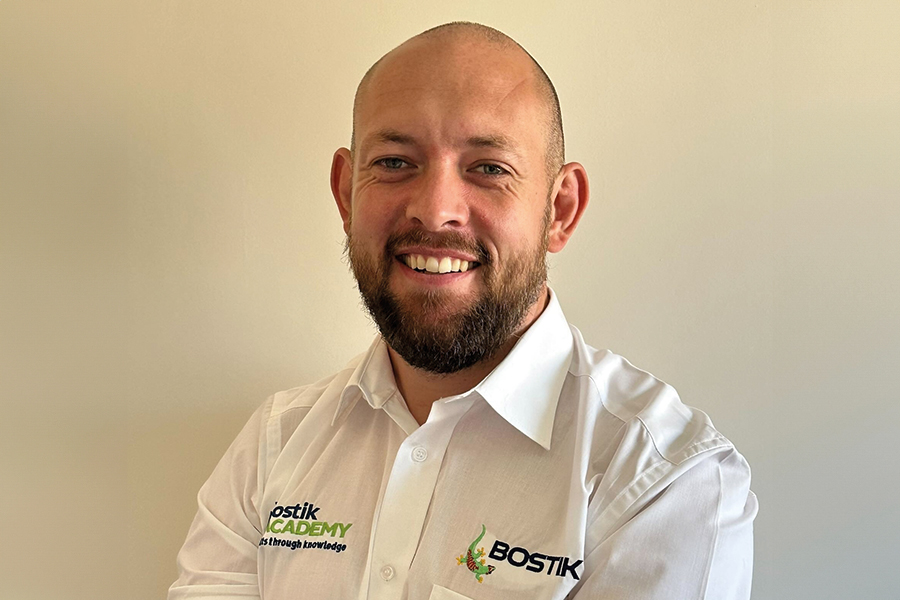Shane Moore provides tips on how to decide which adhesives are most suited for your installations.
WITH the massive growth of LVT in the UK and worldwide, selecting the appropriate floor regarding colour or design isn’t the only factor to consider. As professionals, we must also consider the needs of the project. Is it commercial or residential, what level of foot traffic will it receive, and will there be heavy moving objects or equipment, are just some of the considerations. We must also consider the type of substrate and how we can properly prepare it for installation.
But the first thing we must evaluate is the environment in which the floorcoverings are going to be installed. Glazing, orientation, temperature fluctuations and underfloor heating are all important factors that need to be considered.
The environment and usage of the area should determine the products that will need to be used. Solar gain is a phrase we hear often in flooring. This refers to times when strong natural sunlight shines through the glazing and hits the flooring. Prolonged exposure to this can lead to the flooring becoming over heated and dimensionally unstable, with it wanting to expand and push against the neighbouring tiles. Obviously, when flooring has been exposed to higher temperatures there subsequently comes a fall in temperature. This is referred to as thermal cycling. Thermal cycling can lead to expansion and contraction of the flooring, which may continue until the flooring becomes gapped against its neighbouring tile or pushes against the tile next to it and both start to lift away from the floor.
Equally, the usage of the area is a strong factor when deciding what adhesives you use. Areas that receive lots of foot traffic or be exposed to heavy rolling loads will require the use of higher strength adhesives or adhesives with bespoke properties. These types of adhesives will provide much higher resistance against the stresses that can be placed on the floor in these environments.
The selection of the appropriate adhesive is crucial in ensuring a flawless installation for you and your client. Although there are numerous adhesive types available in the market that are suitable for LVT, the question remains whether all of them are suitable for the environment. Let’s delve deeper into this.
Premium adhesives:
In many cases, LVT can be installed without the need for a specialised adhesive. However, certain circumstances may require a high bond strength and an adhesive that provides an early window of receptiveness that remains workable for an extended period. Premium adhesives offer exactly that. These adhesives can become useable in 5mins once they have been applied and can remain receptive for up to 60mins or more.
Pressure sensitive adhesives:
The use of pressure sensitive adhesives is widely preferred owing to its numerous advantages such as easy application, extensive coverage, and extended open time. However, it’s crucial to avoid leaving the adhesive for too long before placing the LVT to ensure effective bonding. It may not be suitable for areas with high solar gain.
High temperature adhesives
High temperature adhesives (HT) are ideal for installations that’ll be exposed to high solar gain or areas that have warming properties, like underfloor heating. When there are fluctuations in temperature, the floorcovering can change dimensions multiple times, but HT adhesives are designed to provide a higher bond level and are better equipped to resist this. They work exceptionally well in areas that’ll experience high solar gain, such as bifold doors. With a shorter waiting time before placing the LVT into the adhesive, these adhesives lose their receptiveness quickly compared to other types. However, once cured, they provide a strong bond that prevents LVT from moving and allows the tiles to remain stable.
PU, MS and Epoxy adhesives:
In cases where a stronger bond or additional qualities are needed, such as those present in areas that receive high foot traffic, dynamic loads, excess water, or extremes of temperatures, like a walk-in cold store, PU, MS, and Epoxy adhesives provide a heavy-duty solution that can tackle multiple factors that standard adhesives may struggle with. Increased bond strength, moisture resistance, flexibility and extreme temperature tolerance, these adhesives are a suitable option for more bespoke environments.
Tackifiers:
Yes, you read it correctly – tackifiers. We’re referring to LVT adhesives, but not all LVTs require full bonding to the floor. In fact, there are many ‘loose lay’ flooring options available. These tiles are specially designed with added materials to increase stability and allow them to be installed using only tackifier adhesive. This makes them easy to remove later if required, ideal for raised access flooring areas where access may be required underneath the tiles. However, it’s important to note the adhesive needs time to fully dry before applying any floor covering. If installers allow the adhesive to work properly and dry completely, the removal of the floor covering should be a breeze.
If you’d like to know more on what adhesive would work for the right environment, come along for some training. Contact Bostik training Manager Paul Sycamore Paul.sycamore@bostik.com to get booked onto the next course.
www.bostik.co.uk
Shane Moore is technical consultant at Bostik


